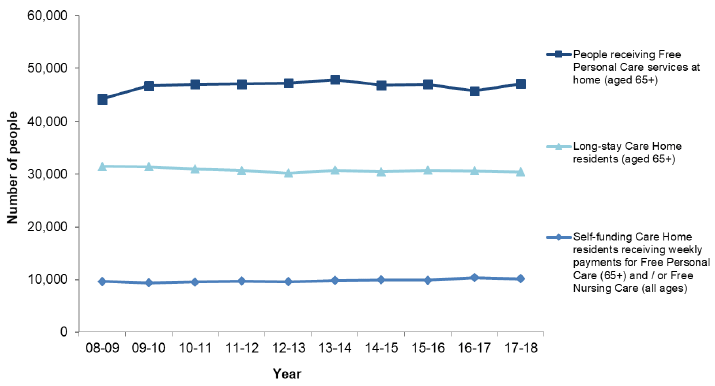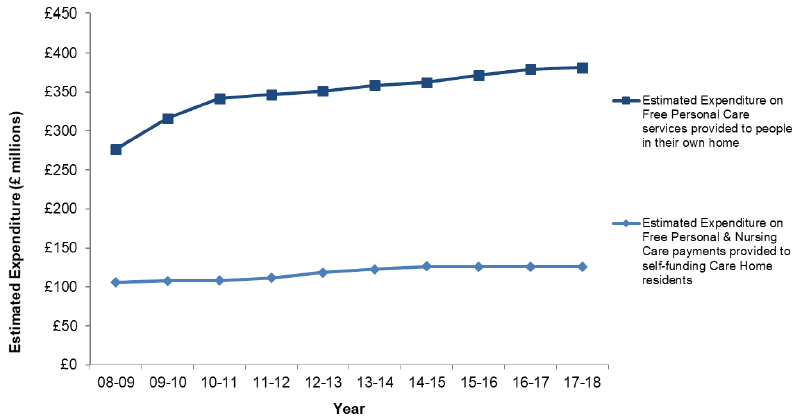Free personal and nursing care, Scotland, 2017-18
Statistics release presenting client and expenditure figures for financial year 2017 to 2018 for free personal and nursing care (FPNC).
1. Introduction
Free Personal and Nursing Care (FPNC) was introduced in Scotland on 1st July 2002. Since then:
Care Homes
- care home residents aged 65 and over who are assessed as self-funders can receive a weekly payment towards their personal care
- people of all ages who live in care homes and are assessed as self-funders can receive a weekly payment if they require nursing care
- the remainder of the care home fees for self-funders are paid by the resident
- care home residents who are funded by their Local Authority receive all of their personal care for free
Home Care
- people aged 65 and over can no longer be charged for personal care services provided in their own home. Such individuals can still be charged for certain domestic services but any charge would be subject to a financial assessment
This Statistics Release presents the latest figures (financial year 2017-18) to give a picture of the number of people that benefit from FPNC in Scotland and the amount that Local Authorities spend on personal care services.
1.1 Number of FPNC Clients
Nearly 80,000 people in Scotland benefit from Free Personal and Nursing Care, with over 30,000 people in Care Homes and over 47,000 people living in their own home. Over 10,000 self-funding Care Home residents receive weekly payments for Free Personal Care (ages 65+) and / or Free Nursing Care (all ages).
Figure 1: People receiving FPNC, 2008-09 to 2017-18

1.2 Care Homes
The overall number of older people in Care Homes has reduced slightly over the last ten years, from around 31,530 in 2008-09 to 30,450 in 2017-18.
In 2017-18 there were around 10,080 older people receiving Free Personal Care payments, slightly down on the 10,350 reported in the previous year. These payments are available to self-funding Care Home residents who have assets, including property, worth more than £26,000 (from 7th April 2014). Around a third (33%) of all Care Home residents received FPNC payments in 2017-18.
The remaining Care Home residents are publicly funded and also receive Personal and Nursing Care services for free. These residents contribute towards their Care Home fees from their pensions and any other income they may have. The Local Authority then funds the balance, which will be greater than the FPNC payments received by self-funding Care Home residents.
Around three-fifths (61%) of people receiving the Free Personal Care payments also received the Free Nursing Care payment in 2017-18, roughly the same as in the previous year.
1.3 Home Care
In 2017-18 there were around 47,070 older people receiving personal care services in their own homes. This number has increased from 45,660 last year and represents a long term increase from 44,200 older people in 2008-09. Since July 2002, Local Authorities in Scotland can no longer charge for these services. Please note that the source of this data has changed for 2017-18 which will impact on comparisons with prior years.
The overall trend of more people receiving personal care services in their own homes likely reflects two underlying factors: an increasing older population, and a move away from long-term care being provided in hospitals and Care Homes towards care being provided in people's own homes for as long as possible.
People receiving personal care services at home received on average 8.8 hours of care per week in 2017-18, similar to the 8.9 average hours in 2016-17. The long term trend shows growth in this measure which was 7.5 hours in 2008-09.
In 2017-18, 95% of older people receiving Home Care services received personal care as part of their care package, compared with 81% in 2008-09. This may reflect a tightening of eligibility criteria over the years.
1.4 Expenditure
Due to differences in recording practice across Local Authorities, the expenditure figures presented in this report have been adjusted to include estimates for overheads. The figures at Scotland-level are broadly comparable year-on-year, but contain some degree of estimation. For more details on expenditure, see Sections 4.3 - 4.5 of this report.
Figure 2: Estimated Expenditure on FPNC (£ millions), 2008-09 to 2017-18

Source: LFR03 Return / Scottish Government FPNC validation return. Figures presented contain an estimation of overheads
In 2017-18, the amount spent by Local Authorities on FPNC payments to self-funding Care Home residents totaled £126 million, unchanged from the previous year. Overall, this figure has increased from £106 million in 2008-09 which likely reflects the annual increases in the FPNC payments from April 2008. The overall increase in expenditure represents new money arising from the FPNC policy, as prior to its introduction self-funders would have had to pay for all of their care.
In 2017-18 the amount spent by Local Authorities on providing personal care services to older people in their own home totaled £381 million, an increase on £379 million the previous year. Overall, this figure has increased from £277 million in 2008-09.
The increase in expenditure over time is driven by a combination of factors. Firstly, an increasing proportion of older people are cared for at home, rather than in hospital or Care Homes. Secondly, Home Care workers are increasingly providing personal care services rather than domestic services. And lastly, people living at home have increasing levels of need. It should be noted however, that this is not all new spend arising from the FPNC policy. Prior to 1st July 2002, Local Authorities had discretion to charge for these services and a variety of charging policies operated across the country. Any charges were subject to a financial assessment which meant that in practice many people received these services for free.
Contact
Email: SWStat@gov.scot
There is a problem
Thanks for your feedback